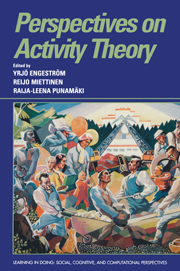Book contents
- Frontmatter
- Contents
- List of contributors
- Series foreword
- Introduction
- Part I Theoretical issues
- Part II Language and its acquisition
- Part III Play, learning, and instruction
- Part IV Technology and work
- 21 The theory of activity changed by information technology
- 22 Activity theory, transformation of work, and information systems design
- 23 Innovative learning in work teams: Analyzing cycles of knowledge creation in practice
- Part V Therapy and addiction
- Author index
- Subject index
22 - Activity theory, transformation of work, and information systems design
Published online by Cambridge University Press: 05 June 2012
- Frontmatter
- Contents
- List of contributors
- Series foreword
- Introduction
- Part I Theoretical issues
- Part II Language and its acquisition
- Part III Play, learning, and instruction
- Part IV Technology and work
- 21 The theory of activity changed by information technology
- 22 Activity theory, transformation of work, and information systems design
- 23 Innovative learning in work teams: Analyzing cycles of knowledge creation in practice
- Part V Therapy and addiction
- Author index
- Subject index
Summary
Introduction
We are living in a period of transition – a search for a new paradigm for information systems (IS) is going on. New research approaches, based on different assumptions, are emerging, and the discussion is being broadened and intensified. At the core of the debate lies the question of how to handle contextuality in IS design and therefore in IS research. It now seems to be generally accepted that designing the technical “core system” alone is insufficient, and that in order to design and implement a successful IS some kind of “context” has to be taken into account – a context that includes people and their relations. Thus, the question is how to obtain reliable, useful results when the object of study belongs – at least partially – to the realm of the social sciences.
Earlier there was also much discussion about the technical or social nature of IS and the practical consequences of this distinction – how social systems can be studied and developed. During the 1970s, the original, strictly technologically oriented view was challenged by the “sociotechnical” school of design, which gained a firm footing especially in the United Kingdom and Scandinavia. During the 1980s, however, the differentiation of research approaches gained new momentum and considerable visibility, with the emergence of a new wave of approaches. These sought their conceptual foundation in the realms of the various social sciences and proceeded much further than the sociotechnical school has done.
- Type
- Chapter
- Information
- Perspectives on Activity Theory , pp. 360 - 376Publisher: Cambridge University PressPrint publication year: 1999
- 38
- Cited by



